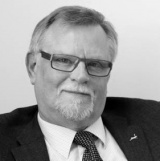
Rovaniemi. Photo: City of Rovaniemi - Arno Torvinen
3 Nov 2015
Rovaniemi: An Arctic insider view
Transport and the development of infrastructure in the Arctic needs better coordination between the neighbours—Finland, Sweden and Norway. “This is not an easy task, but attitudes are changing as the world is benchmarking us”, says Esko Lotvonen, Mayor of Rovaniemi, a growth centre for the one third of Finland that lies within the Arctic Circle.
NIB Newsletter asked Mr Lotvonen to comment on the needs of his city and the Arctic region from the insider perspective.
Rovaniemi, a city of 60,000, the capital of the Lapland County and a logistical hub in Arctic Finland, has been investing heavily in its infrastructure in recent years. To support the municipal investment programme, NIB has provided a total of EUR 27 million in long-term lending for the expansion of water supply and sewage collection networks, road construction and maintenance, the construction of an education centre and upgrading street lighting.
“Rovaniemi is growing and developing. We expect the upward demographic trends to increase the demand for improved infrastructure and municipal services”, says Mr Lotvonen.
He proudly underscores that Rovaniemi is a regional engine for northern Finland, and gives some examples of what’s in the making for the city.
Mining companies run their operations from headquarters in Rovaniemi. There are plans for building a modern waste-to-energy plant. Attracting visitors from all over the world, the city is set to upgrade the airfield of Santa Claus’s Official Airport. New educational centres will host modern schools and facilitate the integration of people with different cultural backgrounds into Finnish society.
However, unlike in the city, the population in rural areas is declining. There are also significant differences between the neighbouring countries.
“There is strong demand for skilled labour in Arctic Norway—the oil and gas industry will make sure this part of Norway has good development prospects. Northern Sweden is also very dynamic. The mining industry and city renewal projects keep attracting private investments. Northern Finland constructs more in the tourist sector and mining.”
When it comes to the Arctic policies of the Nordic countries, “the most pressing needs are investments in roads and railways and the coordination of labour market policies”.
“Norway and Sweden need labour, whereas Finland has higher unemployment than its Arctic neighbours”, Mr Lotvonen explains.
“Transport and the labour market are tough areas, and hatching coordinated policies for the Arctic region is not an easy task.”
And yet, make no mistake—the attitude towards the north is changing. State leaders from faraway countries are paying visits to Rovaniemi. Some are considering co-investing in Arctic projects.

“The world is benchmarking the development in the Arctic, because the Arctic ice pack is melting and new transport corridors are very likely to emerge in the coming decades.”
Esko Lotvonen
Mayor of Rovaniemi since 2012.
In the past two decades, Mr Lotvonen has been in charge of a number of regional development programmes in Lapland.
Photo: City of Rovaniemi – Timo Törmänen
He believes there will be a need for the presence of international financial institutions, including NIB.
“When we go forward with the infrastructure projects, there is a clear need for longer-term financing.”
The Lapland Chamber of Commerce has calculated that the region can expect more than EUR 2 billion in private and state investment projects to commence in the region in the next five years—most of them in mining, transport and power generation. A new boost to ore mining is expected in the Sodankylä area, further north of Rovaniemi, in the coming years. This will require investments in a new railway line from Rovaniemi that would be extended to Kirkenes on Norway’s Barents Sea shore.
“This is a vision. Road and railways planned for the Arctic region, as well as the expected mining projects, will be very powerful impulses for further development”, Mr Lotvonen concludes.